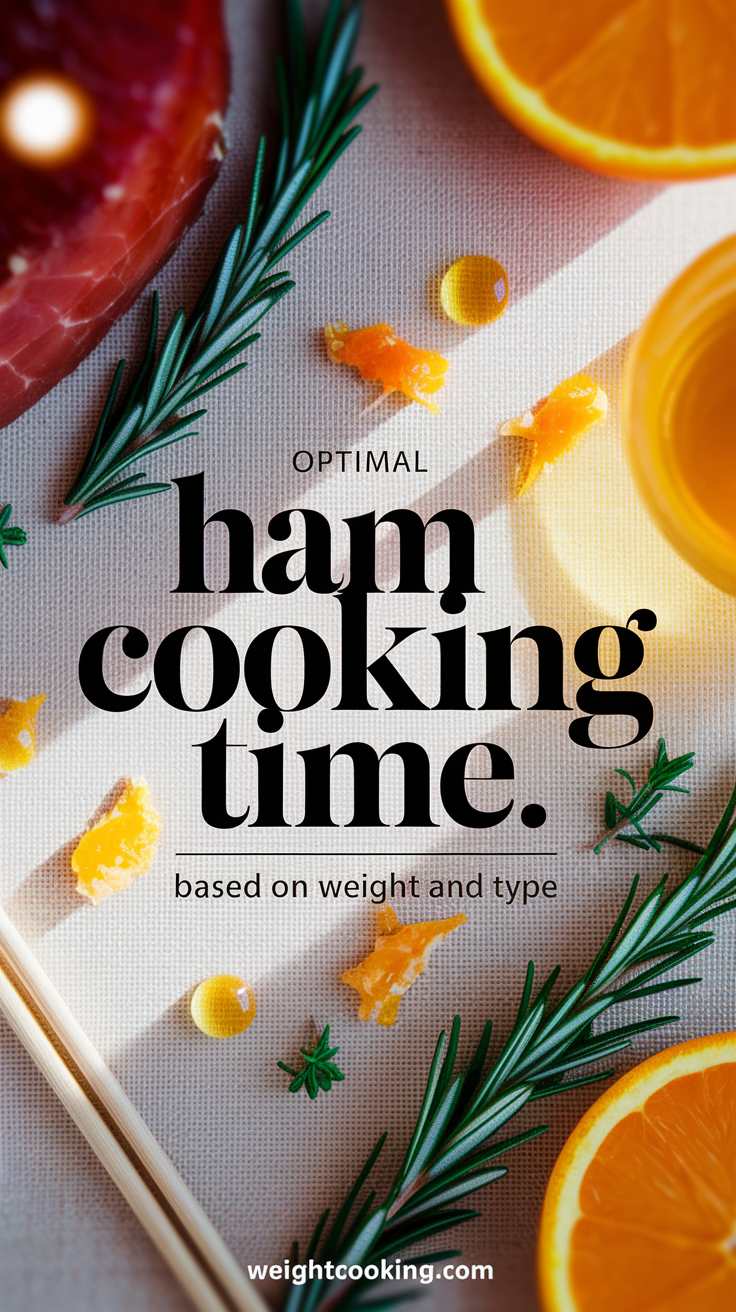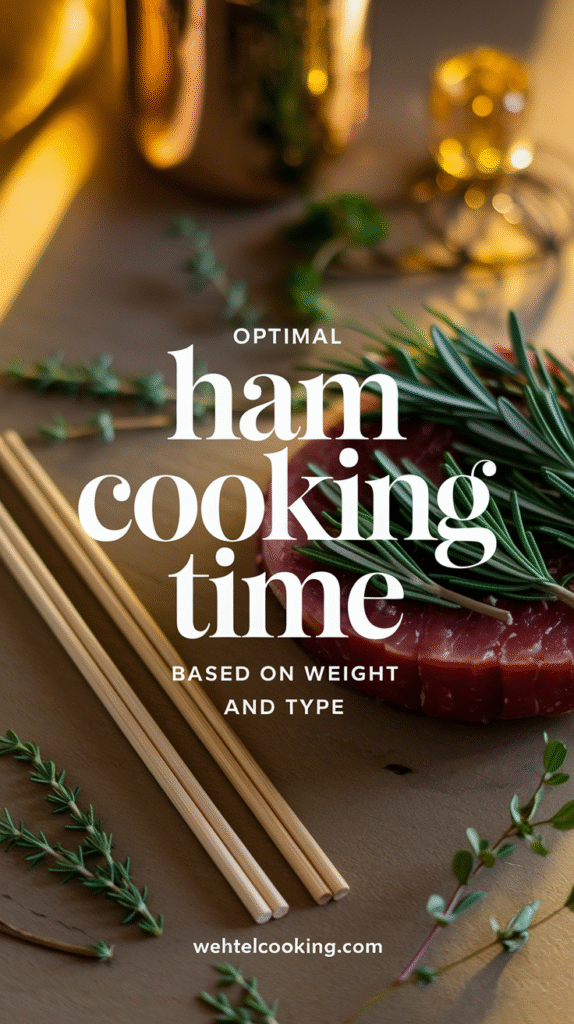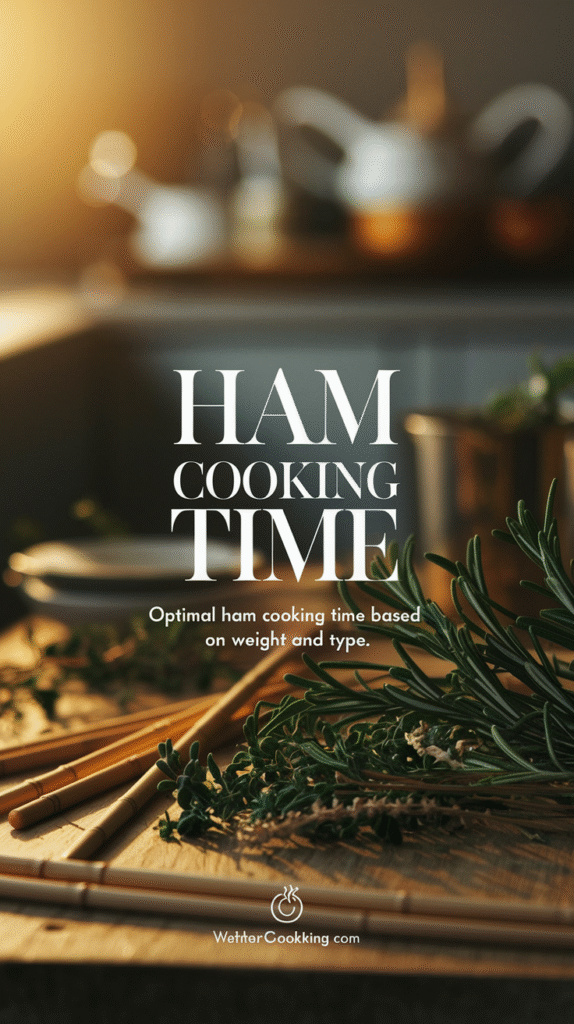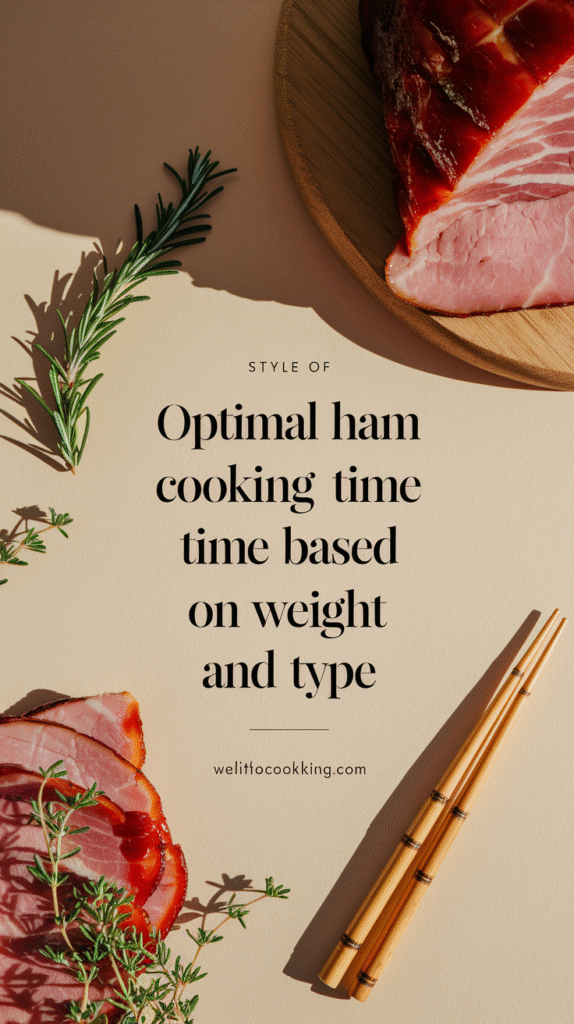Cooking ham can be a delightful experience, especially when you get the timing just right. The optimal ham cooking time largely depends on the type of ham and its weight. Here’s how you can ensure your ham is cooked perfectly.
There are two main types of ham: fresh (uncooked) and cured (smoked or pre-cooked). Each type has its own cooking requirements. Understanding these aspects will help you determine the ideal cooking time.
For cooking hams, follow these general guidelines:
Cooking Times for Different Types of Ham
- Fresh Ham: This type of ham must be thoroughly cooked. The cooking time is approximately 18 to 20 minutes per pound at 325°F (163°C).
- Cured Ham: Cured ham can be precooked or completely cooked:
- Fully Cooked (Pre-cooked) Ham: Heat thoroughly, about 10 to 12 minutes per pound.
- Uncooked Cured Ham: Cook for 18 to 20 minutes per pound.
- Glazed Ham: If you’re making a glazed ham, apply glaze during the last 30 to 45 minutes of cooking.
Weight-Based Cooking Table
| Weight of Ham (lbs) | Cooking Time (minutes per lb) | Total Cooking Time (hrs) |
|---|---|---|
| 5 | 20 | 1.5 |
| 10 | 18 | 3.0 |
| 15 | 18 | 4.5 |
| 20 | 16 | 5.3 |
Remember, achieving the perfect ham isn’t just about the timing; it’s critical to ensure you reach the safe internal temperature. The USDA recommends that cooked ham should reach an internal temperature of at least 140°F (60°C) when reheating and 145°F (63°C) for fresh ham.
Tools for Accurate Cooking
Using the right tools can significantly improve your ham cooking experience:
- Meat Thermometer: This is the most effective way to check if your ham is safe to eat. Always insert it into the thickest part of the meat, avoiding the bone.
- Aluminum Foil: Covering your ham with foil can prevent it from drying out during cooking.
- Roasting Pan: A deep roasting pan can hold juices and keep your ham moist as it cooks.
If you need further guidance on ham cooking times, consider visiting FoodSafety.gov for tips on safe cooking practices.
Once you’ve cooked your ham, let it rest for at least 20 minutes before slicing. This allows the juices to redistribute, resulting in a moist and flavorful presentation.
Cooking ham can vary based on preparation methods. If you plan to have a spiral-cut ham, it may take less time to warm up due to the slicing. Generally, the cooking time for a spiral-cut ham is around 10 minutes per pound. Again, ensure it has reached the desired internal temperature of 140°F (60°C) before serving.
Experimenting with different flavor profiles through glazes and marinades can enhance your ham significantly. Popular glaze options include honey, brown sugar, and maple syrup, often combined with mustard or spices for an extra kick.
Don’t hesitate to seek advice or recipes online. Websites such as AllRecipes provide resources that can help you tailor the cooking time and flavor to best suit your family’s preferences.
The optimal cooking time for ham is about understanding the type and weight. Always utilize appropriate tools and aim for the right internal temperature for a successful meal. Proper preparation can turn ham into a delicious centerpiece for any dinner table.
The Science Behind Cooking Ham: Achieving Perfect Juiciness
Cooking ham to perfection requires understanding a few essential principles to ensure that the meat is juicy, tender, and flavorful. There is a science behind the cooking method, the temperature, and the timing that results in the ideal dish.
The Importance of Cooking Time
Ham cooking time varies based on the type of ham being prepared. Typically, there are two types of ham: pre-cooked and raw. Pre-cooked hams only need to be reheated, while raw hams require thorough cooking. Here’s a quick guide on cooking times:
| Type of Ham | Cooking Method | Estimated Cooking Time |
|---|---|---|
| Pre-cooked Ham | Bake at 325°F | 10-14 minutes per pound |
| Raw Ham | Cook until internal temperature reaches 145°F | 20-25 minutes per pound |
The Role of Temperature
Temperature is crucial in cooking ham. The recommended internal temperature for ham is 145°F (63°C). Using a meat thermometer ensures accurate measurement. This temperature guarantees that the meat is safe to eat while retaining its juices. Cooking ham at lower temperatures can lead to drying out the meat.
Methods for Cooking Ham
There are various methods to cook ham, each producing a unique flavor profile and texture. Here are some popular methods:
- Baking: Baking is the most common method and allows the ham to develop a nice crust. Place the ham in a roasting pan with water for moisture.
- Glazing: Applying a glaze during the last 30 minutes of baking adds flavor and sweetness. Common glaze ingredients include brown sugar, honey, and mustard.
- Slow Cooking: A slow cooker is ideal for cooking ham low and slow, ensuring that the meat remains juicy. This method allows for a hands-off approach, making it simple to prepare.
- Grilling: For a smoky flavor, grilling can be an excellent option. The key is to keep the heat low and cook slowly to avoid charring the outside while keeping the inside moist.
Enhancing Flavor and Moisture
To achieve the perfect juiciness in ham, consider brining before cooking. A simple brine can consist of water, salt, and sugar. This process allows the meat to absorb moisture and flavors, leading to a tender dish. Additionally, adding spices such as cloves or cinnamon during cooking can elevate the taste.
Resting the Ham
Once the ham is cooked, don’t forget to let it rest. A 15-20 minute resting period will help redistribute the juices throughout the meat, preventing them from running out when sliced. Cover the ham loosely with foil during this time to retain warmth.
Common Mistakes to Avoid
There are a few mistakes to watch out for to ensure a perfectly cooked ham:
- Skipping the Thermometer: Always use a thermometer for accuracy.
- Overcooking: Monitor the cooking time closely to avoid a dry ham.
- Ignoring Rest Time: Allow the ham to rest before serving.
Cooking ham can be simple and rewarding when you understand the science behind it. Understanding cooking times, temperatures, and different methods can help you achieve the feast you desire.
For more detailed information about cooking tips and techniques, consider visiting Food Network or Allrecipes.
How to Tell When Your Ham is Done: Internal Temperatures Explained
Cooking ham can be an art form that challenges both novice and experienced cooks alike. One of the most common questions is how to determine when your ham is thoroughly cooked and safe to eat. Ensuring that you’re cooking your ham to the correct internal temperature is vital for food safety and the overall taste of your dish.
The U.S. Department of Agriculture (USDA) defines safe minimum cooking temperatures for various types of meats. When it comes to ham, the required internal temperature can vary depending on whether it’s a fresh ham or a pre-cooked ham. Understanding these differences helps you avoid undercooking or overcooking your ham, ensuring it’s juicy, flavorful, and safe for consumption.
Types of Ham and Their Cooking Temperatures
Hams can generally be categorized into two types: fresh and cured. Each type has its own cooking time guidelines.
- Fresh Ham: This type of ham is uncured and needs to be cooked to an internal temperature of 145°F (63°C). It is recommended to let it rest for at least 3 minutes after removing it from the heat.
- Cured Ham: If you’re working with a cured or smoked ham, the cooking process is different. Cooked or smoked hams (which have already been cured) need to be heated to an internal temperature of 140°F (60°C). If you decide to cook a whole, uncooked cured ham, aim for an internal temperature of 145°F (63°C).
How to Measure Internal Temperature
To accurately assess the internal temperature of your ham, using a meat thermometer is essential. This tool ensures you can avoid the common pitfalls of guessing. Here’s how to use it:
- Insert the thermometer into the thickest part of the ham, avoiding bones.
- Wait for the reading to stabilize, usually after about 10 seconds.
- Check the temperature against the safe minimum temperatures described above.
Cooking Times for Different Ham Cuts
The cut of ham you use influences how long you will need to cook it. Below is a simple table that outlines suggested cooking times based on the type of ham:
| Type of Ham | Weight (lbs) | Cooking Time (Per Pound) |
|---|---|---|
| Fresh Ham | 8-10 | 24-26 min |
| Cooked Ham (Whole) | 10-14 | 15-18 min |
| Cooked Ham (Half) | 5-7 | 18-24 min |
| Baked Ham (Bone-In) | 10-14 | 15-18 min |
These times can vary based on your oven’s specific performance and the ham’s initial temperature before cooking. A good practice is to start checking the internal temperature about an hour before the suggested cooking time to ensure you don’t overcook it.
Other Tips to Ensure Your Ham is Done
Cooking ham to the correct temperature is foundational; however, there are other factors to keep in mind:
- Resting Time: Always allow the ham to rest after removing it from the oven. This enables the juices to redistribute, making for a moist meal.
- Use of Foil: Covering the ham in foil while cooking can help retain moisture while also ensuring a uniform cooking temperature.
- Glazes: If you plan to use a glaze, apply it during the last 30 minutes of cooking to prevent burning.
With this information, you should be well on your way to preparing a perfect ham that is not only safe to eat but also delicious. For more detailed ham cooking methods and recipes, visit FoodSafety.gov or IncredibleHam.com. These sites provide extensive resources for cooking ham and other meats safely.
Glazing Techniques: Enhancing Flavor While Cooking Ham
Cooking ham can be a delightful experience, especially when you incorporate glazing techniques that not only enhance flavor but also create a beautiful presentation. Glazing adds an extra layer of taste and texture, transforming a simple ham into a show-stopping centerpiece. Here’s how you can master glazing techniques for your next ham dish.
Why Glaze Ham?
Glazing serves multiple purposes when it comes to cooking ham:
- Flavor Enhancement: A well-crafted glaze infuses the ham with sweetness, tanginess, or spice, elevating the overall profile.
- Aesthetic Appeal: A glaze can create a glossy surface, making the dish visually captivating.
- Moisture Retention: Applying a glaze during cooking helps lock in moisture, ensuring that your ham is juicy and tender.
Popular Glaze Ingredients
When choosing a glaze, consider combinations that will complement the savory profile of the ham:
| Flavor Base | Sweetener | Acid |
|---|---|---|
| Mustard or Honey | Brown Sugar or Maple Syrup | Pineapple Juice or Apple Cider Vinegar |
| Barbecue Sauce | Honey | Lemon Juice |
| Spices | Agave Nectar | Balsamic Vinegar |
Combining these ingredients allows you to create a unique glaze. Feel free to experiment with your favorite flavors.
Common Glazing Techniques
There are various techniques you can use to apply a glaze to your ham:
- Simple Brush Technique: This involves using a pastry brush to apply the glaze during the final stages of cooking. Brush every 20-30 minutes to build up layers of flavor.
- Glaze and Bake: After the initial cooking time, increase the temperature, apply the glaze generously, and bake until caramelized.
- Broiling: For a quick finish, apply your glaze and place the ham under the broiler for a few minutes, keeping a close eye to prevent burning.
Timing Your Glaze
The timing of your glazing is crucial for achieving the best results. Here’s a quick guide on when to glaze your ham based on cooking time:
| Ham Size | Cooking Time | Glazing Start Time |
|---|---|---|
| 5 to 7 lbs | 1.5 to 2 hours | 30 minutes before it’s done |
| 8 to 10 lbs | 2 to 2.5 hours | 50 minutes before it’s done |
| 11 to 14 lbs | 2.5 to 3 hours | 1 hour before it’s done |
Monitoring your ham’s internal temperature is also crucial for the best results. Generally, a cooked ham should reach an internal temperature of 140°F (60°C) when fully glazed and done.
Types of Hams and Glazing Options
Understanding the type of ham you are cooking is vital, as different varieties pair well with certain glazes:
- Smithfield Ham: Try a maple syrup glaze for a sweet, rich flavor.
- Spiral-Cut Ham: A honey-mustard glaze accentuates its tenderness.
- Country Ham: A spicy glaze with brown sugar brings out its savory notes.
For more tips on glazing and enhancing your cooking skills, check out websites like Food Network and Epicurious.
By understanding the importance of glazing techniques, you can transform your ham into a flavorful dish that impresses your family and friends. So don’t hesitate to try different combinations and methods to find what works best for you!
Common Mistakes to Avoid When Cooking Ham
Cooking ham can be a delicious and rewarding experience, but it comes with its share of challenges. Making mistakes in the process can lead to dry, overcooked, or bland results. Here are some common pitfalls to avoid when cooking ham to ensure a mouthwatering meal every time.
Choosing the Wrong Ham
One of the first mistakes is selecting the wrong type of ham. There are several kinds, including:
- Fresh Ham: Uncooked and must be fully cooked before serving.
- City Ham: Cured with water and ready to eat after warming.
- Country Ham: Dry-cured and typically requires longer cooking times.
- Spiral-Cut Ham: Pre-sliced for easy serving, often pre-cooked.
Understanding the type of ham you are dealing with can dictate not only cooking time but also the seasoning required.
Ignoring the Cooking Time
Each ham type has its specific cooking time. Ignoring these guidelines can lead to undercooked or overcooked meat. Here’s a basic guideline:
| Type of Ham | Cooking Time (per pound) |
|---|---|
| Pre-Cooked Ham | 10-15 minutes |
| Uncooked Fresh Ham | 20-25 minutes |
| Country Ham | 18-20 minutes |
Make sure to use a meat thermometer to check that ham reaches the right internal temperature, which is typically around 145°F (63°C).
Not Letting It Rest
When you take your ham out of the oven, be patient. One common mistake is slicing it right away. Allow the ham to rest for at least 20 minutes to let the juices redistribute. This will result in a juicier and more flavorful dish.
Overdoing the Glaze
A glaze can elevate your ham’s flavor, but too much can lead to a sticky, overly sweet crust. Follow these tips for glazing:
- Apply the glaze during the last 30 minutes of cooking.
- Use a modest amount-a little goes a long way.
- Consider savory additions like mustard or herbs to balance sweetness.
By using a well-cooked, balanced glaze, you can enhance flavor without overwhelming the natural taste of the ham.
Skipping the Seasoning
While ham is often cured, many cooks make the error of not seasoning further. Even cured hams can benefit from additional spices. Here are some seasoning suggestions:
- Black pepper
- Garlic powder
- Thyme or rosemary
- Brown sugar for sweetness
Ensure you apply these seasonings early on to let them infuse into the meat.
Not Using a Proper Cooking Method
Different methods can yield different results. Some popular methods include baking, boiling, or slow cooking. Each method has its pros and cons:
- Baking: Creates a golden, crispy exterior but requires careful monitoring.
- Boiling: This can help to keep ham moist but may lose some flavor.
- Slow Cooking: Ideal for busy cooks, allowing flavors to meld over hours, but can lead to loss of texture.
Forgetting About the Leftovers
Many overlook the potential of ham leftovers. Rather than letting it sit in the fridge, consider these options:
- Make ham sandwiches for lunch.
- Incorporate it into soups and casseroles.
- Chop it for breakfast scrambles or omelets.
Leftover ham can be just as delightful as the main dish!
By avoiding these common mistakes, you’ll be well on your way to preparing a delicious ham that your family and friends will love. For more tips on cooking ham, check out [Smithfield](https://www.smithfield.com/) and [Honey Baked Ham](https://www.honeybaked.com/) for additional recipes and guidance.
Conclusion
Cooking ham to perfection is an art that combines knowledge of optimal cooking times, understanding the science behind achieving juiciness, and mastering techniques that enhance flavor. By considering the weight and type of ham, you can determine the best cooking time to ensure your meal is just right. Remember, reaching the proper internal temperature is crucial for not only flavor but also food safety. Utilizing a reliable meat thermometer will give you confidence in knowing when your ham is fully cooked.
Moreover, glazing your ham opens up a world of flavor possibilities that can elevate your dish from good to unforgettable. Experiment with different glaze recipes to find what works best for your taste buds, but be mindful of the timing to avoid burnt sugar or overly caramelized coatings.
As with any cooking endeavor, there are common mistakes to watch out for. Avoid overcooking or undercooking, which can lead to dry or unsafe meat. Planning ahead and following these guidelines can help ensure your ham is moist, flavorful, and the highlight of any gathering.
By focusing on these aspects—optimal cooking times based on weight and type, understanding juiciness, proper internal temperatures, glazing techniques, and avoiding mistakes—you’re well on your way to serving a delicious ham that will impress your guests and leave them wanting more. Embrace the process, enjoy your time in the kitchen, and savor the delightful results of your hard work.







Leave a Reply